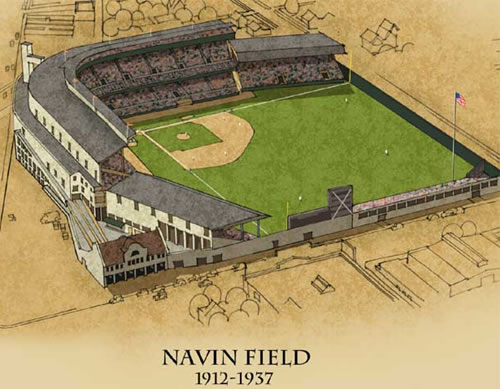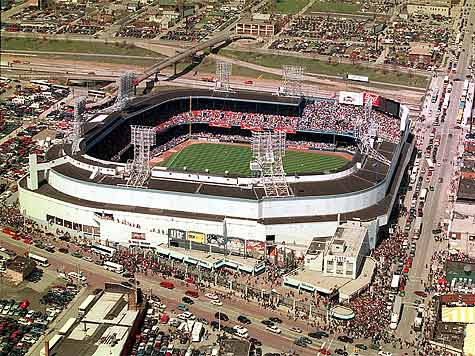Before moving into what became Tiger
Stadium, the Detroit franchise played at Recreation Park and
Boulevard Park. After the 1895 season, owner of the Detroit
franchise, George Vanderbeck, decided to build a ballpark at
Michigan and Trumbull. His team, the Detroit Tigers of the
Western League began playing at the 6,000 wooden seat ballpark
on April 28, 1896. Named Bennett Park, the grandstand was in the
shape of a L. A covered grandstand extended from behind third
base to home and attached to a bleacher section along the first
base side. Located in the outfield were trees, the Tigers
clubhouse, and the groundskeepers shed.
 In 1901, the Tigers became part of the American League and the
wooden grandstand was repaired. By the 1908 season, the playing
field was reduced as the main grandstand was extended into the
field by 40 feet. A new bleacher section along the third base
side was added increasing the capacity to 10,000. Bennett Park’s
capacity again increased in 1911 to 18,000 when bleachers were
added in right and left field. Because the stadium was built of
wood, the threat of fire was great. This led to the entire
ballpark being demolished after the 1911 season.
In 1901, the Tigers became part of the American League and the
wooden grandstand was repaired. By the 1908 season, the playing
field was reduced as the main grandstand was extended into the
field by 40 feet. A new bleacher section along the third base
side was added increasing the capacity to 10,000. Bennett Park’s
capacity again increased in 1911 to 18,000 when bleachers were
added in right and left field. Because the stadium was built of
wood, the threat of fire was great. This led to the entire
ballpark being demolished after the 1911 season.
A new ballpark of steel and concrete was
constructed on the same site. Homeplate was moved from right
field to where it was until Tiger Stadium closed. The new
ballpark was named Navin Field and the Tigers played their first
game at the ballpark on April 20, 1912. It could seat 23,000
spectators as a covered grandstand extended down the first and
third base lines with bleachers in right field. In centerfield
was the first baseball hitters backdrop in baseball. The first
major addition to Navin Field occured before the 1923 season
when a second deck was added between the first and third base
and a press box was added on top of the roof. This addition
increased the capacity at Navin Field rose to 30,000.
 The 1930s gave Tiger Stadium its look that
it retained for 70 years. In 1935, Navin Field was renamed
Briggs Stadium after owner Walter O. Briggs. A series of
expansions began prior to the 1936 season. The single deck
pavilion that extended down the first base line and around into
right field was double decked. Before the addition could be
built in right field, a problem had to be solved. Trumbull
Avenue was located behind the right field fence therefore the
grandstands could not be expanded out. To solve the problem, the
right field line was shortened to 325 feet and the upper deck
extended over the lower deck and over the playing field 10 feet.
Construction was completed by April 1937 and Briggs Stadium
could seat 36,000 fans. After the 1937 season an additional
expansion was completed at Briggs Stadium. The single deck
pavilion that extended down the third base line and around into
left field was double decked. A gap between the double decks in
right and left field was filled with two decks of bleachers with
the scoreboard placed on top. With this expansion, Briggs
Stadium was now enclosed and had a capacity of 54,500, making it
one of baseballs largest stadiums. Dimensions were 340 ft.
(left), 440 ft. (center), and 325 ft. (right).
The 1930s gave Tiger Stadium its look that
it retained for 70 years. In 1935, Navin Field was renamed
Briggs Stadium after owner Walter O. Briggs. A series of
expansions began prior to the 1936 season. The single deck
pavilion that extended down the first base line and around into
right field was double decked. Before the addition could be
built in right field, a problem had to be solved. Trumbull
Avenue was located behind the right field fence therefore the
grandstands could not be expanded out. To solve the problem, the
right field line was shortened to 325 feet and the upper deck
extended over the lower deck and over the playing field 10 feet.
Construction was completed by April 1937 and Briggs Stadium
could seat 36,000 fans. After the 1937 season an additional
expansion was completed at Briggs Stadium. The single deck
pavilion that extended down the third base line and around into
left field was double decked. A gap between the double decks in
right and left field was filled with two decks of bleachers with
the scoreboard placed on top. With this expansion, Briggs
Stadium was now enclosed and had a capacity of 54,500, making it
one of baseballs largest stadiums. Dimensions were 340 ft.
(left), 440 ft. (center), and 325 ft. (right).
 Night
baseball came to Briggs Stadium on June 15, 1948. During the
same year, the press box was extended around the third deck. In
1961, Briggs Stadium was renamed Tiger Stadium when the team was
bought by John Fetzer. Tiger fans became outraged in 1972 when
Fetzer announced that he was going to build a new multipurpose
stadium. At the polls that year, voters rejected bonds to
construct a new stadium. Navin Field/Briggs Stadium/Tiger
Stadium also hosted many other events other than baseball. The
Detroit Lions (NFL) and other football teams played at the
ballpark from 1938 to 1974. Boxing matches, concerts, and many
other activities took place at the stadium. Fire broke out at
Tiger Stadium in 1977 and destroyed the press box. The city of
Detroit bought the stadium from the Tigers for $1 and decided to
renovate Tiger Stadium. All of the original green wooden seats
were replaced by new orange and blue plastic seats, a new video
scoreboard replaced the old hand operated one in centerfield,
and a new press box with two luxury suites were hung from the
second deck. In 1993, $8 million in expansions were completed at
Tiger Stadium, including building a food court called the Tiger
Plaza, where the players once parked.
Night
baseball came to Briggs Stadium on June 15, 1948. During the
same year, the press box was extended around the third deck. In
1961, Briggs Stadium was renamed Tiger Stadium when the team was
bought by John Fetzer. Tiger fans became outraged in 1972 when
Fetzer announced that he was going to build a new multipurpose
stadium. At the polls that year, voters rejected bonds to
construct a new stadium. Navin Field/Briggs Stadium/Tiger
Stadium also hosted many other events other than baseball. The
Detroit Lions (NFL) and other football teams played at the
ballpark from 1938 to 1974. Boxing matches, concerts, and many
other activities took place at the stadium. Fire broke out at
Tiger Stadium in 1977 and destroyed the press box. The city of
Detroit bought the stadium from the Tigers for $1 and decided to
renovate Tiger Stadium. All of the original green wooden seats
were replaced by new orange and blue plastic seats, a new video
scoreboard replaced the old hand operated one in centerfield,
and a new press box with two luxury suites were hung from the
second deck. In 1993, $8 million in expansions were completed at
Tiger Stadium, including building a food court called the Tiger
Plaza, where the players once parked.
Detroit Tiger fans continued to enjoy
going to baseball games at the corner of Michigan and Trumbull
until it closed. Many fans did not mind the columns that may
have been in front of their seat or other obstructed views. The
overhang in right field provided many homeruns that may not have
been homeruns in other ballparks and the flagpole in centerfield
could cause problems for outfielders. If a Tiger fan did not sit
in the bleachers in the outfield listening to Ernie Harwell on a
hand held radio, they did not know what they were missing. From
the green grass to the green seats and eventually the blue and
orange seats, Tiger Stadium reminded fans what baseball was like
in 1914. By the early 1990s the owner of the Tigers wanted a new
luxurious ballpark for team. A new ballpark for the Tigers was
built in downtown Detroit, and the club moved to
Comerica Park after the 1999 season. The last game at Tiger
Stadium was on September 27, 1999. Many fans were saddened when
the last game was played at "The Corner". For over seven years,
there has been talk of college or minor league baseball teams
using the facility along with other sports. However, the City of
Detroit does not seem interested in allowing any sporting events
at the stadium. Unfortunately, in June 2006 the City of Detroit
announced plans to tear down Tiger Stadium this fall and winter.
In its place will be retail shops and residential housing
surrounding the historic playing field, which will be preserved
as a nonprofit park and ball diamond

